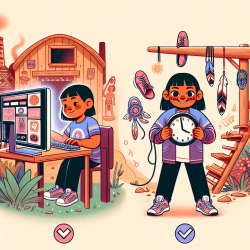As a practitioner working with American Indian youth, understanding the intricate balance between sleep, physical activity (PA), and screen time is crucial for promoting healthier lifestyles. A recent study titled Sleep Time, Physical Activity, and Screen Time among Montana American Indian Youth sheds light on these critical behaviors and offers insights that can be implemented in educational settings to foster better health outcomes.
The Study's Key Findings
The research conducted among Montana American Indian youth revealed several significant findings:
- Sleep Patterns: The study found that American Indian youth average 7.8 hours of sleep per night, which is below the recommended 8-10 hours for teenagers. This lack of sufficient sleep can impact both physical and mental development.
- Physical Activity Disparities: Boys were found to engage in more light and vigorous physical activities compared to girls. However, overall levels of physical activity were low across the board.
- Screen Time Concerns: High levels of screen time were observed, with notable differences between boys and girls depending on their grade level. This excessive screen time is linked to obesity and reduced physical activity.
Implementing Research Insights in Practice
Practitioners can leverage these findings to enhance their interventions and support strategies:
- Promote Healthy Sleep Habits: Encourage students to establish regular sleep routines by educating them about the importance of adequate rest. Consider workshops or informational sessions for both students and parents to raise awareness about the impact of sleep on health.
- Facilitate Physical Activity Opportunities: Create more opportunities for physical activities within school programs. Encourage participation in sports or after-school activities that promote movement and exercise.
- Address Screen Time Usage: Educate students about the effects of excessive screen time on health. Implement guidelines or programs that encourage balanced use of technology and promote alternative activities.
The Importance of Further Research
This study highlights the need for continued research into the health behaviors of American Indian youth. By understanding these behaviors more deeply, practitioners can develop targeted interventions that address specific needs within this community. Further research could explore factors such as socioeconomic influences, cultural aspects, and environmental barriers that affect health behaviors.
The findings from this study serve as a foundation for practitioners aiming to improve the health outcomes of American Indian youth. By implementing the insights gained from this research into practical strategies, educators and therapists can play a pivotal role in promoting healthier lifestyles among their students.
To read the original research paper, please follow this link: Sleep Time, Physical Activity, and Screen Time among Montana American Indian Youth.










